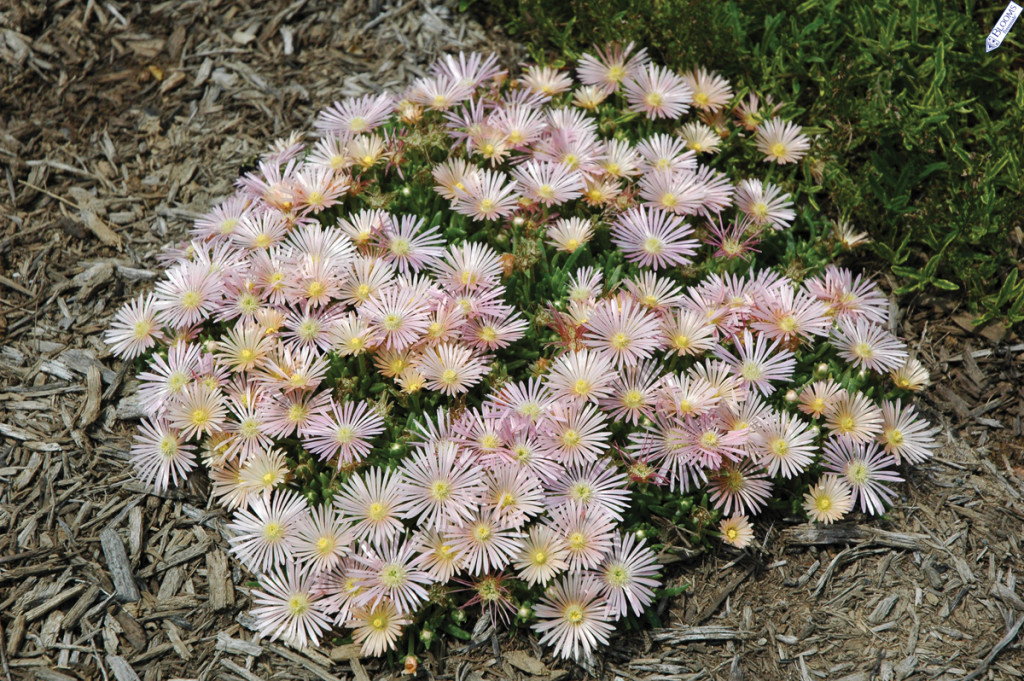
Perennial Solutions: Delosperma ‘Mesa Verde’
Delosperma, commonly referred to as ice plant, is an underutilized plant that has great potential in perennial programs. Ice plant forms low-growing mats of succulent foliage with daisy-like flowers and grows well throughout much of the United States. Delosperma ‘Mesa Verde’ produces an impressive display of iridescent salmon-pink flowers against its gray-green foliage. ‘Mesa Verde’ was discovered by the Denver Botanic Gardens and is brought to Blooms of Bressingham by Plant Select.
‘Mesa Verde’ forms a green mat with succulent jellybean-like leaves. The compact plants grow two to three inches tall and spreads 12 to 18 inches across in the landscape. It spreads quickly, but not aggressively. When blooming begins in the late spring, the plants produce an abundance of shimmering daisy-like flowers in a range of salmon-pink colorations all summer long.
Delosperma performs best in sunny locations with good drainage throughout USDA Hardiness Zones 4 to 8. It grows well in hot, dry sites with poor soils. Ice plant is an ideal candidate for rock gardens, edging in a perennial garden or as a groundcover. Another great selling point; they are resistant to deer feeding. With its tidy, succulent appearance and stunning flower colorations, delosperma ‘Mesa Verde’ makes a great addition to perennial program looking to offer unique and reliable plants.
Propagation
Delosperma ‘Mesa Verde’ is vegetatively propagated from tip cuttings. Growers receiving unrooted cuttings (URCs) should moisten the rooting medium in the liner trays prior to sticking the cuttings. For the first few days of propagation, provide a medium misting frequency; then move them to a low misting regime. Gradually decrease the mist frequency over time during propagation. Too much misting during propagation leads to poor root initiation and rotting of the foliage. The main key to successfully rooting delosperma is to propagate them with the least amount of misting as possible.
It is beneficial to begin feeding with 50- to 100-ppm nitrogen at least once per week beginning 10 days after sticking. Delosperma usually takes three to four weeks with soil temperatures ranging from 68 to 72° F to root. To promote branching, it is beneficial to pinch the liners after they are removed from propagation or a least a couple of weeks before transplanting. Liners reach a transplantable size five to seven weeks after sticking.
Production
‘Mesa Verde’ is suitable for production in one gallon or smaller sized containers with a single liner planted in the center of the pot. When planting, the growing medium should be even with the top of the plug. Ice plant performs best when grown in a porous, well-drained medium with a slightly acidic pH: 5.5 to 6.5. Many commercially available peat or bark based growing mixes work well provided there is good water holding ability and more importantly, adequate drainage.
Delosperma prefer to be grown moderately dry; avoid extended wet periods. When irrigation is necessary, water them thoroughly then allow the soil to dry moderately between irrigations. Avoid overwatering them. They are light feeders. Nutrients are commonly delivered using water-soluble sources, providing 75 to 100 ppm using a constant liquid fertilizer program or 150 ppm as needed. With the compact growing habit of ‘Mesa Verde’, it is not necessary to apply growth regulators to reduce control plant height.
Insects and Diseases
There are only a few problems with insects or diseases that growers are likely to experience. During propagation, feeding injury from fungus gnat larvae can occasionally become problematic. Otherwise, aphids are the most common insect pests growers are likely to observe. Crown and root rots are the most common plant pathogens of delosperma. The occurrence of crown and root rots can be avoided with good irrigation management and avoiding periods of overly wet growing conditions. Insects and diseases can be detected with routine crop monitoring; control strategies may not be necessary unless the scouting activities indicate actions should be taken.
Scheduling
Delosperma ‘Mesa Verde’ is best produced for late spring to early summer sales. It does not require cold for flowering. Plants can be bulked up in the fall and overwintered or transplanted in the spring using vernalized or unvernalized liners. Although it is a compact plant, it fills out the containers nicely in a reasonable amount of time. Ice plant will flower under any photoperiod and can be forced into bloom under natural day lengths. Fall plantings can be forced into bloom in seven to eight weeks when they are grown at 65 to 68° F; spring plantings using unvernalized liners will take approximately nine to 10 weeks to bulk up and flower.
Availability
Delosperma ‘Mesa Verde’ is brought to the market by Blooms of Bressingham. Unrooted cuttings (URCs) and rooted liners can be acquired from Greenleaf Perennials (www.glplants.com). Liners are also available from numerous reputable plant brokers and perennial propagators.


 Video Library
Video Library 




















